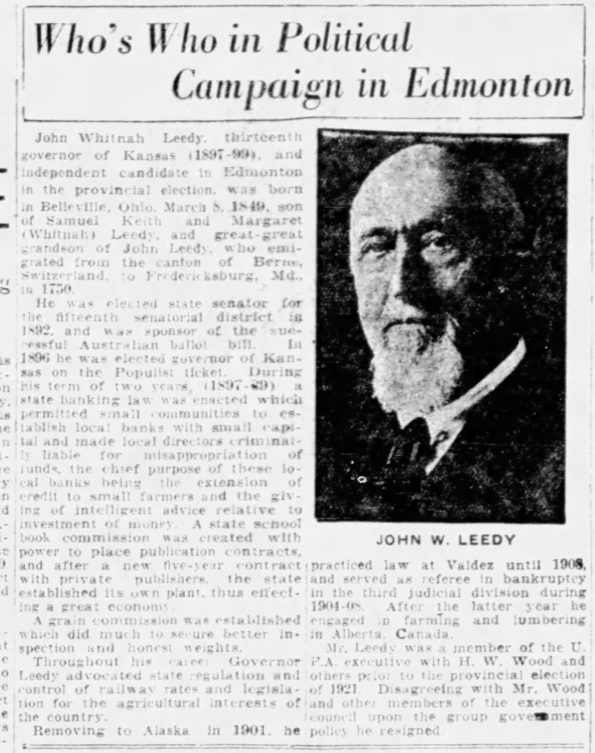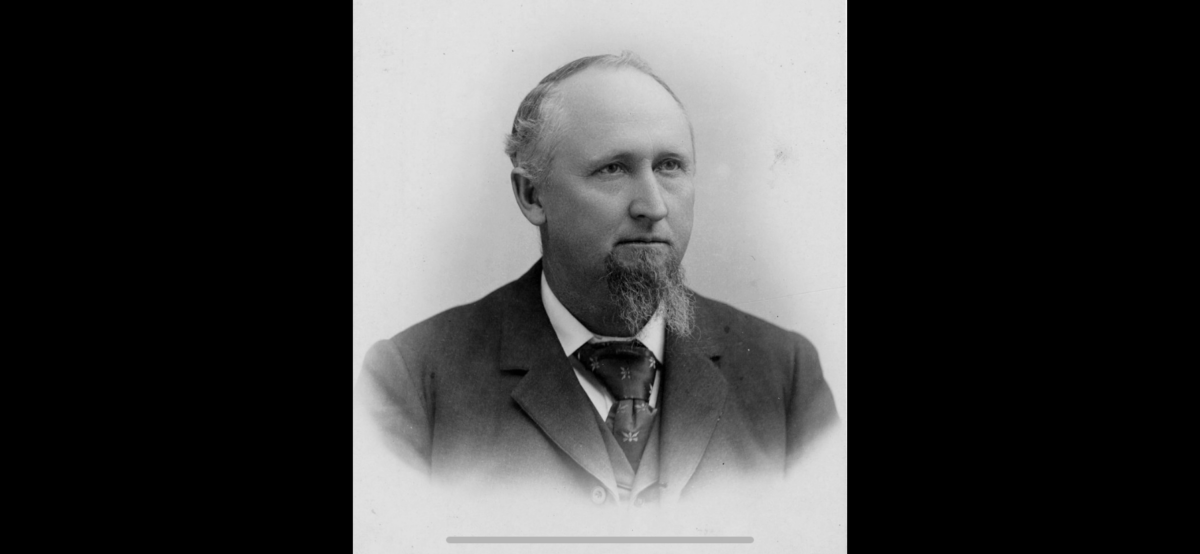Alberta’s political history is filled with colourful characters, but perhaps one of the most unlikely, and unlucky, was John Leedy. But before Leddy even arrived in Alberta in 1910, he had already served as the Governor and a State Senator in Kansas and a mayor and city attorney in Alaska.
Born in Ohio in 1849, John Leedy was elected to the Kansas State Senate in 1893 and served there until he was elected Governor of Kansas in 1897 while leading the Populist Party ticket to a full sweep in that year’s election.
 Asked what in his opinion caused the defeat of the Republicans in that year’s election, Leedy told the Kansas City Gazette in November 1896 that “I attribute the defeat of the Republican party in Kansas more to the fact that the sate of Kansas is for free silver, than to any other cause.”
Asked what in his opinion caused the defeat of the Republicans in that year’s election, Leedy told the Kansas City Gazette in November 1896 that “I attribute the defeat of the Republican party in Kansas more to the fact that the sate of Kansas is for free silver, than to any other cause.”

“The next legislature will pass laws which will afford the people of Kansas, at least, an equal opportunity for existences long with the corporations,” Leedy said, referencing his criticisms that the large railway companies had too much influence over politics in Kansas.
Two years later, Leedy lost his party’s nomination and the Republicans regained control of the Governorship in Kansas.
Leedy moved to Alaska in 1901 following his first big electoral defeat in what some Kansan newspaper described as an “Alaskan exile.” He practiced law in Alaska, despite never having actually studied law. And he didn’t stay out of politics for long.
He lost by one vote in his first bid for election as city attorney of the City of Valdez, according to a report by the Osbourne County Farmer. He was later elected as city attorney and served as mayor of Valdez.
He quit his job as city attorney in 1910 and applied to become a British subject in order to move to Canada to start a farm near Whitecourt, Alberta.

Even in a different country, farming couldn’t quench his thirst for politics. He joined the United Farmers of Alberta and became very active in the farming advocacy group, serving on the UFA executive and working closely with UFA president Henry Wise Wood.
The Kansas City Journal described him as a “fighting man,” “the kind that fights at the drop of the hat and drops the hat himself.”
So, true to character, he jumped back into electoral politics.
“Edmonton is so far north it would appear that even a Kansan’s desire to be a member of the legislature might be frosted,” wrote the Kansas City Star in April 1916. “If he gets into the Alberta legislature the Conservative Canadians will head the Kansas language as she is spoke. For Leedy’s desire to go to the legislature shows that he is still a Kansan.”
Leedy ran in the June 1917 provincial election under the Non-Partisan League banner alongside fellow candidates Louise McKinney and James Weir. He ran the southern Alberta district of Gleichen and placed third with 17 per cent of the vote.

Months later he ran in the December 1917 federal election in the rural Alberta riding of Victoria, placing third with 7.9 per cent of the vote. He appears to have relocated from Whitecourt to Edmonton after these two electoral defeats.
He split with Wise Wood shortly after the UFA’s surprise sweeping win in the 1921 election and resigned from the UFA executive.
Following his split with the UFA, he became an enthusiastic promoter of monetary reform, calling for the creation of a smaller localized banking system over a centralized system dominated by central Canadian banks. He also clashed with evangelical followers of Social Credit theory during the big monetary reform debates of the 1920s and 1930s.
An April 1922 report in the Financial Post described Leedy as “one of those who has achieved a reputation in this country as a bank baiter,” having once published a pamphlet describing bankers as “our overlords” who “have skinned the farmer instead of shearing him.”

After a break from electoral politics, he announced plans to jump back into electoral politics in 1925 as an Independent Progressive in Edmonton East in the federal election but he did not make it on to the ballot.
His next and final run for elected office would happen in 1926, when he advocated for monetary reform as an Independent candidate for MLA in Edmonton’s multi-member district. He eared 0.75 per cent of the vote and placed last out of 18 candidates.
Continuing to promote monetary reform theories, at age 83 he took his first trip in a airplane when flying back to Kansas in 1932 to give bankers monetary advice.
In an Edmonton Journal article marking his 86th birthday, Leedy credited his longevity to “accepting his doctor’s advice to move to a colder climate.”
Leedy died in Edmonton on March 24, 1935 and is buried in the Edmonton Municipal Cemetery. His wife, Sarah Boyd Leedy died in 1941 and is also buried in the Edmonton Municipal Cemetery.
Upon notice of his death, the Kansas House of Representatives voted to provide $1,000 to meet the burial expenses for him and his wife and erect a burial monument.

